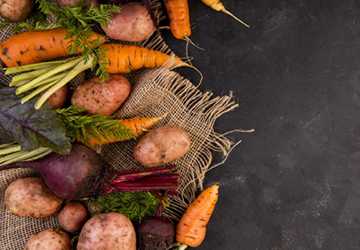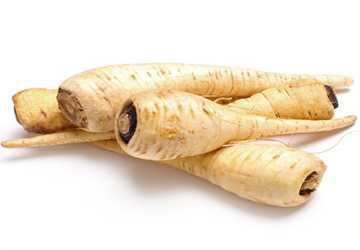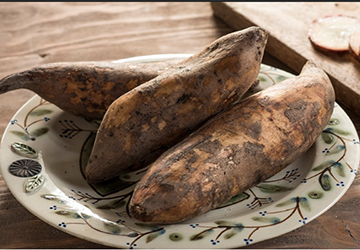Regarding vegetables, we often find ourselves stuck in a culinary rut, relying on the same old potatoes, carrots, and onions to fill our plates. But did you know that a world of root vegetables is waiting to be explored, each with a unique flavour and texture? This article will introduce you to the top 10 root vegetables you've probably never tried. These underground wonders not only add variety to your meals but also offer a plethora of health benefits. So, let's dive in and discover the hidden treasures of the root vegetable world!

Salsify, also known as the "oyster plant" due to its subtle oyster-like flavour, is an often overlooked root vegetable. It boasts a long, slender, and somewhat gnarled root with a creamy white interior. Salsify can be prepared in various ways, from roasting and frying to mashing, and it pairs beautifully with garlic and butter, creating a unique culinary experience. Its flavour is often described as a delicate blend of artichoke hearts and asparagus, making it a fantastic addition to your root vegetable repertoire.
Jicama, pronounced "hee-kah-ma," is a root vegetable native to Mexico, and it's sometimes referred to as the "Mexican turnip." This crunchy and slightly sweet tuber is perfect for adding a refreshing crunch to your salads or snacking on with a dash of lime juice and chilli powder. Its mild, apple-like flavour and water chestnut-like texture make it a versatile ingredient for savoury and sweet dishes.
Burdock is a root vegetable commonly used in traditional Asian and European cuisines. It has a long, slender shape with a tough brown exterior and a crisp white interior. With its earthy and slightly sweet flavour, burdock is often used in soups, stir-fries, and herbal teas. It's known for its potential health benefits, such as detoxifying properties and anti-inflammatory effects.
Parsnips may not be entirely unfamiliar, but their more famous relative often overshadows them, the carrot. When roasted or mashed, these pale, carrot-like roots have a sweeter, nuttier flavour. They are a great source of dietary fibre, vitamins, and minerals. Try parsnips in your following roast vegetable medley, and you won't be disappointed.

Celeriac, also known as celery root, may not win any beauty contests with its knobby appearance, but it's a flavour powerhouse. This root vegetable has a distinct celery flavour and a creamy, potato-like texture. It's a versatile ingredient that can be mashed, roasted, or turned into a creamy soup. Celeriac is an excellent source of vitamin K and phosphorus, making it a nutritious addition to your diet.
Rutabaga, often called the "swede" in the UK, is a cross between a cabbage and a turnip. It has a sweet, slightly peppery flavour that becomes milder when cooked. Rutabagas can be boiled, mashed, roasted, or added to stews. They are rich in vitamin C and dietary fibre, making them a healthy meal choice.
Yacon is a lesser-known root vegetable native to South America. It resembles a sweet potato in appearance and has a crisp texture like jicama. Yacon is known for its sweet and juicy flavour, making it a healthy and refreshing snack. It's also used to make yacon syrup, a natural sweetener with a low glycemic index, suitable for those watching their sugar intake.

Kohlrabi, sometimes called the "German turnip," is a peculiar-looking vegetable with a thick stem and two tufted leaves at the top. Its flavour is a mild blend of broccoli stems and cabbage, making it a fantastic addition to salads or slaws. Kohlrabi can be taken raw or cooked and is a valid source of vitamins C and B6 and dietary fibre.
Jerusalem artichokes, often known as sunchokes, are knobby tubers with a nutty, slightly sweet taste with hints of artichoke. They can be roasted, mashed, or turned into a creamy soup, and their unique flavour can add depth to your dishes. Jerusalem artichokes are a good iron, potassium, and dietary fibre source.
Taro is a starchy root vegetable commonly used in Asian and Pacific Island cuisines. Its flesh is usually purple or white and has a sweet, nutty flavour. Taro is often used to make taro chips, dumplings, and sweet desserts like taro bubble tea. It's rich in fibre, vitamins, and minerals, making it a nutritious and delicious choice.
Now that you're acquainted with these ten intriguing root vegetables, you can add flavour and nutrition to your meals. These vegetables offer unique tastes and textures and provide various health benefits, including vitamins, minerals, and dietary fibre. Feel free to experiment with these root vegetables in your kitchen and discover exciting new flavours and dishes. Here are a few tips for incorporating them into your meals:
Roasting: Many root vegetables, such as parsnips, rutabagas, and salsify, can be roasted for a caramelized, savoury flavour.
Mashing: Celeriac and parsnips make excellent additions to your mashed potato recipes, adding unique flavours and extra nutrients.
Soups and Stews: Burdock and Jerusalem artichokes can be added to soups and stews for their distinctive flavours and nutritional benefits.
Raw in Salads: Kohlrabi and jicama can be sliced, grated, and added to salads for a refreshing crunch.
Snacking: Yacon and taro can be enjoyed raw or cooked to satisfy your sweet or savoury cravings.
So, the next time you're at the grocery store or local farmer's market, watch for these lesser-known root vegetables. They have the potential to transform your meals into delightful culinary adventures and boost your overall health. Take advantage of the opportunity to expand your palate and add variety to your diet with these root vegetable gems. Happy cooking and happy eating!